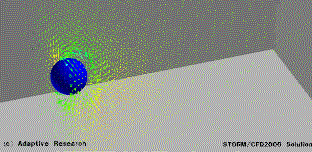|
STORM is a general purpose computer program designed to numerically solve the
Navier-Stokes equations, which consist of conservation equations for mass,
momentum, and energy. In addition, it is capable of solving an arbitrary number
of general transport equations. STORM uses a finite-volume representation of the
governing equations, whereby the continuous problem domain is decomposed into
multiple control volumes, and the governing equations are applied to individual
control volumes and integrated over the entire computational domain. This
algebraic equation set is then solved using general and efficient numerical
methods to obtain a solution of the engineering system.

To obtain the greatest possible accuracy, speed, efficiency, and flexibility
from STORM, Adaptive Research designed and integrated a number of innovative
techniques into the program.
The PISO Algorithm
The PISO (Pressure Implicit with Splitting of Operators) algorithm used by the
STORM Solver produces time-accurate calculation results when simulating
transient phenomena; results superior to those produced by older finite volume
algorithms. To achieve steady-state condition, PISO simply neglects the
transient behavior, and marches in large time steps towards the converged
solution. A unique algorithm splitting process, coupled with an implicit scheme,
makes STORM more computationally efficient, less memory intensive, and more
flexible than other finite volume methodologies.
Multiple Coordinate Systems
With STORM Solver, you may choose between Cartesian, Cylindrical-polar, or Body-Fitted
coordinate systems to get the power and flexibility demanded by a particular
problem. A mesh generated from body-fitted coordinates more exactly represents
geometry contours and allows more accurate treatment of boundary and surface
conditions in the model. Cartesian and cylindrical systems more simply represent
geometry; and can save time in simulations involving less complex geometries or
qualitative flow analyses.
High-Order Convection Scheme
STORM Solver lets you select from first, second, or third-order convection
schemes, or a hybrid method. For problems where convection is negligible or the
transport equations do not have convection terms, the solver provides the option
to turn the terms off. The second and third-order schemes produce results with
higher accuracy.
Finite-Volume Methodology
Finite-volume treatment of equations in general curvilinear coordinates produces
accurate results on any smoothly varying grid-even in the presence of
significant non-orthogonality. Using the integral form of equations, the finite-volume
methodology enforces conservation.
Mesh Sequencing
In some applications, mesh sequencing improves convergence rates by an order of
magnitude or more. STORM Solver provides an interactive mesh density control.
With it, you can coarsen or refine the grid during program execution in any or
all coordinate directions In response, STORM refines the grid, updates boundary
conditions, monitors point location, and interpolates the field solution to the
new grid-automatically.
|









